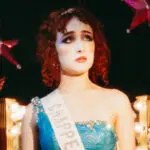Table of Contents
 A Relentless Output, A Personal Turn
A Relentless Output, A Personal Turn
Since ‘Call Me By Your Name’ in 2017, Luca Guadagnino has quietly become one of the most consistently productive auteurs working today. He’s not quite working on a clock- but it’s close. With near-annual feature releases, plus the occasional short film or music video nestled in between, Guadagnino’s output is beginning to resemble Woody Allen’s in terms of consistency- that is, if Guadagnino can keep the pace up for another forty-something years.
This year continues the streak. After releasing what he has called his most personal project yet, ‘Queer’ (now streaming on HBO Max), Guadagnino already has another film on deck. ‘After the Hunt,’ a psychological drama is set for release this October, starring Julia Roberts and Andrew Garfield, as well as two Guadagnino alums- Chloë Sevigny (‘Bones and All’) and Michael Stuhlbarg (‘Call Me By Your Name’).
Luca Guadagnino’s relationship with ‘Queer’ began long before he stepped behind the camera. As a teenager in 1980s Palermo, he discovered William S. Burroughs’ novella and felt an immediate, personal jolt- an encounter that sparked his first, clumsy attempt at screenwriting. He was just 21 when he tried adapting it for the screen, unaware that this early, private obsession would evolve- decades later, with the help of his ‘Challengers’ screenwriter, Justin Kuritzkes– into what he described to Cinnecittá as “[his] most personal film.”
Things to do:
- Subscribe to The Hollywood Insider’s YouTube Channel, by clicking here.
- Limited Time Offer – FREE Subscription to The Hollywood Insider
- Click here to read more on The Hollywood Insider’s vision, values and mission statement here – Media has the responsibility to better our world – The Hollywood Insider fully focuses on substance and meaningful entertainment, against gossip and scandal, by combining entertainment, education, and philanthropy.
The Scandal of Stillness
In that same interview with Cinecittà, Guadagnino teased that the sex scenes in ‘Queer’ were going to be “numerous and quite scandalous.” And they are- but not in the way the average American moviegoer might expect. The scandal, such as it is, lies not in what is shown, but in how it’s shown. Guadagnino’s signature “patient camera” doesn’t leer or cut away; instead, it lingers with painterly restraint, capturing the physical intimacy between Daniel Craig and Drew Starkey with quiet clarity rather than spectacle.
It’s not gratuitous. Nor is it tasteless. In fact, ‘Queer’ reveals its boldness in what it holds back. To some, yes, it may feel scandalous simply because it refuses to flinch. But anyone who read that quote from Guadagnino and expected something closer to ‘Blue is the Warmest Color’– a film that famously spares us nothing, presenting the full bodies of its actresses during extended, explicit scenes- might walk away disappointed, by how much ‘Queer’ chooses to imply instead of show.
WATCH THE TRAILER of the Film and the Revolution: ‘Can I Go Home Now?’
The Children Around the World Continue to Ask the question
From the Hays Code to No Code
It’s the kind of gesture born of necessity, a relic of the Hays Code era- a censorship framework imposed in 1934 amid growing pressure from religious groups and conservative watchdogs who feared Hollywood’s moral influence. The Code mandated strict moral guidelines, prohibiting explicit sexuality, “perversion,” and even suggestive language, forcing filmmakers to invent clever, indirect ways to imply what they could no longer show outright. Ironically, just a year before the Code’s enforcement, in 1933, the Czech film ‘Ecstasy’ shocked international audiences with what is widely considered the first Cinematic depiction of female orgasm- achieved not through graphic imagery, but through Hedy Kiesler’s (later known as Hedy Lamarr, Golden Age actress and co-inventor of frequency-hopping technology) expressive face. The Hays Code arrived swiftly thereafter, demanding that directors cover not only bodies, but suggestion itself.
And yet, that constraint birthed some of Cinema’s cleverest moments. Hitchcock’s ‘North by Northwest’ famously ends with a train rushing into a tunnel as Cary Grant and Eva Marie Saint get cozy in their sleeper car. In ‘From Here to Eternity,’ crashing waves on rocks follow a passionate kiss on the beach, dissolving into a wisp of cigarette smoke- an era’s shorthand for what just happened. But as time wore on, the old tricks became the punchlines.
Jay Leno tells the story that Johnny Carson knew it was “time to go” when “they”- i.e. the new generation, was not just mocking his act, but the caricature of his act.
Such was the case when ‘Monty Python’s Flying Circus’ spoofed the implication game in a 1969 sketch. A couple, played by Carol Cleveland and Terry Jones, are in bed mid-tryst. As things heat up, the camera cuts away- to stock footage. Back to the couple. More implication, more film reels. Eventually, the woman, cigarette in hand, looks over at the man now fiddling with a projector beside the bed and deadpans, “Oh Beavis, are you going to do anything or are you just going to show me films all evening?”
The Hays Code, it seemed, had worn out the welcome it never really had in the first place.
Related article: Want GUARANTEED SUCCESS? Remove these ten words from your vocabulary| Transform your life INSTANTLY
Related article: Streaming Services Are Killing Movie Theaters
Style, Not Just Skin
Sex is no longer forbidden on film. But that doesn’t mean filmmakers have stopped making choices. The question now isn’t whether to show sex- it’s how to show it.
Some, like the great Gus Van Sant in ‘My Own Private Idaho,’ freeze the moment of intimacy into a tableau vivant, evoking intimacy through painterly stillness. Others, like Spike Jonze in ‘Her,’ skip the visuals entirely: we hear the voices of Joaquin Phoenix and Scarlett Johansson consummate their bond over a black screen, their emotional connection taking precedence over physicality.
On the opposite end of the spectrum, some filmmakers ask us not just to look, but to think about what we’re seeing. Mary Harron’s ‘American Psycho’ frames Christian Bale having sex with a prostitute as he stares at himself in a mirror- narcissism made literal. Christopher Nolan’s ‘Oppenheimer’ makes the choice to visualize a past sexual encounter in the mind of Emily Blunt’s character as the titular character is being interrogated (allegorically undressed, as Nolan visually implicates), illustrating the psychological residue of her husband’s affair.
Guadagnino belongs to a camp of stylists who treat sex with narrative and emotional specificity. He’s unafraid of nudity, yes- but more crucially, he’s unafraid of tone. His sex scenes aren’t just about bodies. They’re about characters, psychology, atmosphere, time, restraint. ‘Queer’ isn’t scandalous because it shows too much. It’s scandalous because it shows just enough that we can sit with it for as long as he holds the shot.
Related article: EVOLUTION: Every Ryan Gosling Role From 1995 to 2020, All Performances Exceptionally Poignant
Related article: EVOLUTION: Every Henry Cavill Role From 2001 to 2021, All Performances Exceptionally Poignant
Related article: All Best Actor/Actress Speeches From The Beginning Of Oscars 1929-2019 | Hollywood Insider
By Joseph Tralongo
Click here to read The Hollywood Insider’s CEO Pritan Ambroase’s love letter to Cinema, TV and Media. An excerpt from the love letter: The Hollywood Insider’s CEO/editor-in-chief Pritan Ambroase affirms, “We have the space and time for all your stories, no matter who/what/where you are. Media/Cinema/TV have a responsibility to better the world and The Hollywood Insider will continue to do so. Talent, diversity and authenticity matter in Cinema/TV, media and storytelling. In fact, I reckon that we should announce “talent-diversity-authenticity-storytelling-Cinema-Oscars-Academy-Awards” as synonyms of each other. We show respect to talent and stories regardless of their skin color, race, gender, sexuality, religion, nationality, etc., thus allowing authenticity into this system just by something as simple as accepting and showing respect to the human species’ factual diversity. We become greater just by respecting and appreciating talent in all its shapes, sizes, and forms. Award winners, which includes nominees, must be chosen on the greatness of their talent ALONE.
I am sure I am speaking for a multitude of Cinema lovers all over the world when I speak of the following sentiments that this medium of art has blessed me with. Cinema taught me about our world, at times in English and at times through the beautiful one-inch bar of subtitles. I learned from the stories in the global movies that we are all alike across all borders. Remember that one of the best symbols of many great civilizations and their prosperity has been the art they have left behind. This art can be in the form of paintings, sculptures, architecture, writings, inventions, etc. For our modern society, Cinema happens to be one of them. Cinema is more than just a form of entertainment, it is an integral part of society. I love the world uniting, be it for Cinema, TV, media, art, fashion, sport, etc.
More Interesting Stories From The Hollywood Insider
– Want GUARANTEED SUCCESS? Remove these ten words from your vocabulary| Transform your life INSTANTLY
– A Tribute to Martin Scorsese: A Complete Analysis of the Life and Career of the Man Who Lives and Breathes Cinema
– Do you know the hidden messages in ‘Call Me By Your Name’? Find out behind the scenes facts in the full commentary and In-depth analysis of the cinematic masterpiece
– A Tribute To The Academy Awards: All Best Actor/Actress Speeches From The Beginning Of Oscars 1929-2019 | From Rami Malek, Leonardo DiCaprio To Denzel Washington, Halle Berry & Beyond | From Olivia Colman, Meryl Streep To Bette Davis & Beyond.
– In the 32nd Year Of His Career, Keanu Reeves’ Face Continues To Reign After Launching Movies Earning Over $4.3 Billion In Total – “John Wick”, “Toy Story 4”, “Matrix”, And Many More

Joseph Tralongo is a playwright and screenwriter who approaches storytelling with a deep respect for film’s ability to distill human behavior into meaningful moments. His personal work- i.e. his plays, screenplays, and films- leans into semantic tension, moral ambiguity, and the quiet unraveling of social dynamics- not to preach, but to parse. For him, writing is a slow excavation of truth through craft. With a background in theatre and independent film, he brings a structural precision and dramatic instinct to every film he reviews. Hollywood Insider’s mission to champion substance over spectacle aligns with Joseph’s belief that storytelling should investigate, not dictate.








